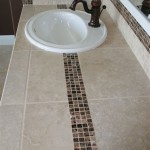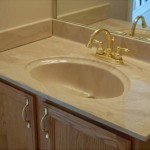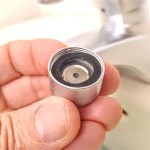Installing a Stopper in a Bathroom Sink: A Comprehensive Guide
A functional stopper is a critical component of any bathroom sink, facilitating water retention for various tasks such as shaving, washing, and cleaning. Over time, stoppers can become corroded, damaged, or simply missing, necessitating replacement. This article provides a detailed, step-by-step guide to installing a new stopper in a bathroom sink, covering various types of stoppers and offering troubleshooting tips for common issues.
Before commencing the installation process, it is imperative to identify the existing type of stopper mechanism. Common types include pop-up stoppers, lift-and-turn stoppers, and push-and-seal stoppers. Each type has a distinct installation procedure, and attempting to install a stopper incompatible with the existing drain assembly can lead to functionality issues and potential damage.
The following sections outline the installation process for several prevalent types of bathroom sink stoppers.
Installing a Pop-Up Stopper
The pop-up stopper is arguably the most common type found in modern bathroom sinks. Its mechanism relies on a lever located behind the drain that, when manipulated, raises or lowers the stopper within the drain opening. Installing a pop-up stopper involves assembling the stopper itself, connecting the horizontal rod, and adjusting the vertical rod to ensure proper operation.
Step 1: Disassembly of the Old Stopper Mechanism
Begin by disconnecting the existing pop-up rod from the drain assembly. This is usually accomplished by loosening a setscrew that secures the rod to a clevis strap. Once the setscrew is loosened, the rod should slide out. Subsequently, remove the old stopper from the drain opening. Depending on the design, the stopper may simply lift out, or it may require a slight rotation to disengage it from the drain body. If the stopper is corroded or stuck, a gentle rocking motion may be necessary to loosen it.
The next step involves disassembling the horizontal pivot rod and clevis strap from the drain tailpiece. Locate the pivot nut that secures the pivot rod housing to the tailpiece. Using adjustable pliers or a wrench, carefully loosen the pivot nut. Be prepared for a small amount of water to drain out as the nut is loosened. Once the nut is removed, the pivot rod can be withdrawn from the tailpiece. Examine the rubber seals and washers associated with the pivot rod for wear or damage. These should be replaced if necessary to prevent leaks.
Step 2: Preparing the New Stopper Assembly
The new pop-up stopper assembly typically comprises the stopper body, a rubber seal or washer, and a horizontal pivot rod. Before installation, ensure that all components are present and free from defects. Apply a small amount of plumber's grease to the rubber seal to improve its lubrication and prevent it from binding during installation. This also helps create a watertight seal.
Step 3: Installing the Drain Flange and Stopper Body
From above the sink, insert the new drain flange into the drain opening. Ensure that the rubber washer or putty is correctly positioned beneath the flange to create a watertight seal between the flange and the sink basin. From beneath the sink, slide the rubber and plastic washers onto the drain tailpiece in the correct order, as indicated in the manufacturer's instructions. Secure the tailpiece to the drain flange by tightening the lock nut. Be careful not to overtighten the lock nut, as this can damage the washers and lead to leaks. A snug fit is sufficient.
Insert the new stopper body into the drain flange from above. The stopper should move freely within the flange, but there should be minimal play. If the stopper feels excessively loose, check the size compatibility between the stopper and the drain flange. Some stoppers come with adjustable collars to accommodate different drain sizes.
Step 4: Connecting the Horizontal Pivot Rod and Vertical Rod
Insert the horizontal pivot rod through the opening in the tailpiece and into the corresponding hole in the stopper body. Ensure that the rod moves freely and engages the stopper mechanism. Secure the pivot rod in place by tightening the pivot nut. Again, avoid overtightening. Position the clevis strap on the vertical rod and connect it to the pivot rod. The clevis strap typically has multiple holes to allow for adjustment of the stopper's height. Adjust the position of the clevis strap on the vertical rod until the stopper is in the desired position (fully open or fully closed) when the vertical rod is actuated. Once the desired position is achieved, tighten the setscrew on the clevis strap to secure it to the vertical rod. Verify that the stopper operates smoothly and seals effectively when the vertical rod is manipulated.
Step 5: Testing for Leaks
After completing the installation, run water into the sink and test for leaks around the drain flange, the pivot nut, and the tailpiece connection. If any leaks are detected, tighten the corresponding connections slightly. If the leaks persist, disassemble the connection, inspect the washers and seals for damage, and reassemble the connection with fresh sealant or plumbing tape if necessary.
Installing a Lift-and-Turn Stopper
The lift-and-turn stopper features a knob or handle on the stopper itself that is lifted and turned to open or close the drain. Installation is generally simpler compared to a pop-up stopper, as it does not involve a complex linkage system.
Step 1: Removing the Old Stopper
Grasp the knob or handle of the old stopper and attempt to unscrew it. Some lift-and-turn stoppers are threaded and can be removed by simply unscrewing them. Others may require a slight upward pull while turning. If the stopper is stuck, apply a penetrating oil to the threads and allow it to soak for a few minutes before attempting to remove it again. In some cases, the stopper may be secured with a setscrew. If a setscrew is present, loosen it before attempting to unscrew the stopper.
Step 2: Installing the New Stopper
The new lift-and-turn stopper will typically have a threaded post that screws into the drain flange. Apply a small amount of plumber's tape or pipe dope to the threads of the post to ensure a watertight seal. Insert the stopper into the drain opening and screw it in until it is snug. Do not overtighten the stopper, as this can damage the threads or crack the drain flange. If the stopper has a setscrew, tighten it to secure the stopper in place.
Step 3: Testing the Stopper
After installation, test the stopper by lifting and turning the knob or handle. The stopper should move smoothly and seal effectively when closed. Fill the sink with water and check for leaks around the stopper. If any leaks are detected, tighten the stopper slightly or reapply plumber's tape to the threads.
Installing a Push-and-Seal Stopper
The push-and-seal stopper, also known as a touch-down stopper, operates by pressing down on the stopper to seal the drain and pressing again to release it. These stoppers are generally easy to install and do not require any tools.
Step 1: Removing the Old Stopper
Most push-and-seal stoppers can be removed by simply pulling them straight up from the drain opening. Some stoppers may have a slight twist-and-pull mechanism. If the stopper is stuck, try gently rocking it back and forth while pulling upwards. Avoid using excessive force, as this can damage the drain flange or the stopper itself.
Step 2: Installing the New Stopper
The new push-and-seal stopper will typically have a rubber seal or O-ring around its base. Ensure that the seal is clean and undamaged. Insert the stopper into the drain opening and press down firmly until it clicks into place. The stopper should now be sealed. Press down on the stopper again to release it. The stopper should pop up slightly, allowing water to drain..
Step 3: Testing the Stopper
Fill the sink with water and check that the stopper seals effectively when closed. Then, press the stopper to release it and ensure that the water drains freely. If the stopper does not seal properly, try adjusting the stopper's height by twisting it slightly while pressing down. Some push-and-seal stoppers have adjustable mechanisms to fine-tune their sealing performance.
Troubleshooting Common Issues
Several issues can arise during stopper installation. One common problem is a leaky drain flange. This can often be resolved by tightening the lock nut beneath the sink or by replacing the rubber washer or putty beneath the flange. Another common issue is a stopper that does not seal properly. This can be caused by a worn or damaged rubber seal, an improperly adjusted linkage, or debris obstructing the drain opening. Clean the drain opening thoroughly and inspect the stopper and its components for damage. Replace any worn parts and readjust the linkage or sealing mechanism as needed.
Another challenge is a stuck or corroded stopper. Apply penetrating oil to the stopper and allow it to soak for several minutes before attempting to remove it. If the stopper is severely corroded, it may be necessary to use pliers or a wrench to grip the stopper and twist it free. Be careful not to damage the drain flange in the process. In extreme cases, the drain tailpiece may need to be replaced if the stopper is fused to it.
Install A Drain Stopper So The Is Removable

How To Replace A Sink Stopper Quick And Simple Home Repair

Bathroom Sink Popup And Stopper Problems

Step By Guide On How To Install Sink Pop Up Drain Stopper

How To Install Bathroom Sink Drain And Pop Up Stopper Diy Drainstopper

Installing A Bathroom Sink Drain Efficient Plumber

How To Replace A Rusty Sink Drain Howtolou Com

Clean Adjust Replace Sink Pop Up Stopper Bathroom Drain Install

How To Install A Bathroom Sink Popup Drain Stopper

Bianchina Swapping Out A Bathroom Sink Drain And Pop Up
Related Posts







